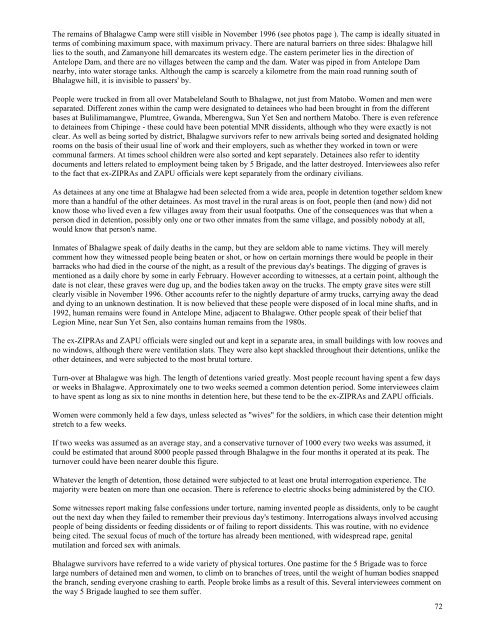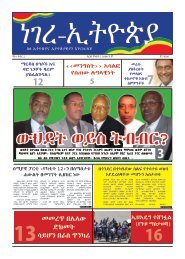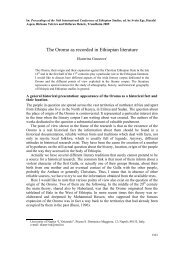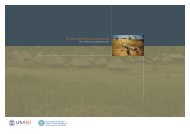MatabelelandReport
MatabelelandReport
MatabelelandReport
You also want an ePaper? Increase the reach of your titles
YUMPU automatically turns print PDFs into web optimized ePapers that Google loves.
The remains of Bhalagwe Camp were still visible in November 1996 (see photos page ). The camp is ideally situated in<br />
terms of combining maximum space, with maximum privacy. There are natural barriers on three sides: Bhalagwe hill<br />
lies to the south, and Zamanyone hill demarcates its western edge. The eastern perimeter lies in the direction of<br />
Antelope Dam, and there are no villages between the camp and the dam. Water was piped in from Antelope Dam<br />
nearby, into water storage tanks. Although the camp is scarcely a kilometre from the main road running south of<br />
Bhalagwe hill, it is invisible to passers' by.<br />
People were trucked in from all over Matabeleland South to Bhalagwe, not just from Matobo. Women and men were<br />
separated. Different zones within the camp were designated to detainees who had been brought in from the different<br />
bases at Bulilimamangwe, Plumtree, Gwanda, Mberengwa, Sun Yet Sen and northern Matobo. There is even reference<br />
to detainees from Chipinge - these could have been potential MNR dissidents, although who they were exactly is not<br />
clear. As well as being sorted by district, Bhalagwe survivors refer to new arrivals being sorted and designated holding<br />
rooms on the basis of their usual line of work and their employers, such as whether they worked in town or were<br />
communal farmers. At times school children were also sorted and kept separately. Detainees also refer to identity<br />
documents and letters related to employment being taken by 5 Brigade, and the latter destroyed. Interviewees also refer<br />
to the fact that ex-ZIPRAs and ZAPU officials were kept separately from the ordinary civilians.<br />
As detainees at any one time at Bhalagwe had been selected from a wide area, people in detention together seldom knew<br />
more than a handful of the other detainees. As most travel in the rural areas is on foot, people then (and now) did not<br />
know those who lived even a few villages away from their usual footpaths. One of the consequences was that when a<br />
person died in detention, possibly only one or two other inmates from the same village, and possibly nobody at all,<br />
would know that person's name.<br />
Inmates of Bhalagwe speak of daily deaths in the camp, but they are seldom able to name victims. They will merely<br />
comment how they witnessed people being beaten or shot, or how on certain mornings there would be people in their<br />
barracks who had died in the course of the night, as a result of the previous day's beatings. The digging of graves is<br />
mentioned as a daily chore by some in early February. However according to witnesses, at a certain point, although the<br />
date is not clear, these graves were dug up, and the bodies taken away on the trucks. The empty grave sites were still<br />
clearly visible in November 1996. Other accounts refer to the nightly departure of army trucks, carrying away the dead<br />
and dying to an unknown destination. It is now believed that these people were disposed of in local mine shafts, and in<br />
1992, human remains were found in Antelope Mine, adjacent to Bhalagwe. Other people speak of their belief that<br />
Legion Mine, near Sun Yet Sen, also contains human remains from the 1980s.<br />
The ex-ZIPRAs and ZAPU officials were singled out and kept in a separate area, in small buildings with low rooves and<br />
no windows, although there were ventilation slats. They were also kept shackled throughout their detentions, unlike the<br />
other detainees, and were subjected to the most brutal torture.<br />
Turn-over at Bhalagwe was high. The length of detentions varied greatly. Most people recount having spent a few days<br />
or weeks in Bhalagwe. Approximately one to two weeks seemed a common detention period. Some interviewees claim<br />
to have spent as long as six to nine months in detention here, but these tend to be the ex-ZIPRAs and ZAPU officials.<br />
Women were commonly held a few days, unless selected as "wives" for the soldiers, in which case their detention might<br />
stretch to a few weeks.<br />
If two weeks was assumed as an average stay, and a conservative turnover of 1000 every two weeks was assumed, it<br />
could be estimated that around 8000 people passed through Bhalagwe in the four months it operated at its peak. The<br />
turnover could have been nearer double this figure.<br />
Whatever the length of detention, those detained were subjected to at least one brutal interrogation experience. The<br />
majority were beaten on more than one occasion. There is reference to electric shocks being administered by the CIO.<br />
Some witnesses report making false confessions under torture, naming invented people as dissidents, only to be caught<br />
out the next day when they failed to remember their previous day's testimony. Interrogations always involved accusing<br />
people of being dissidents or feeding dissidents or of failing to report dissidents. This was routine, with no evidence<br />
being cited. The sexual focus of much of the torture has already been mentioned, with widespread rape, genital<br />
mutilation and forced sex with animals.<br />
Bhalagwe survivors have referred to a wide variety of physical tortures. One pastime for the 5 Brigade was to force<br />
large numbers of detained men and women, to climb on to branches of trees, until the weight of human bodies snapped<br />
the branch, sending everyone crashing to earth. People broke limbs as a result of this. Several interviewees comment on<br />
the way 5 Brigade laughed to see them suffer.<br />
72







